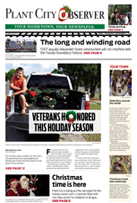
105 S. WHEELER STREET FINALLY BEING REPURPOSED.
Once upon a time, The First National Bank of Plant City printed U.S. national currency. The bank printed for the government between 1912 and 1919. Despite the bank notes displaying series 1902, they were issued by national banks between 1908 and 1928. The Plant City bank issued 3,840 sheets of $5 blue seal bills, 2,805 sheets of blue seal $10 bills, and 2,805 sheets of blue seal $20 bills. The total currency output was $217,050. The printing facility address was 302 W. Haines St. (now Martin Luther King Jr. Blvd.), at the corner of Wheeler St. The First National Bank building for customers stood on the southeast corner of Haines St. and Collins St.
In 1967, the customer service bank relocated to its new 22,000 square-foot building at 105 S. Wheeler St—on the corner of MLK and Wheeler where its printing facility previously stood. The location later became Barnett Bank, then Huntington Bank, then GTE, and eventually became vacant for years. In 2021, the building was purchased to be converted into a food hall similar to The Joinery in Lakeland, but that plan fell through. In 2024, the building was to be converted into a facility that produced radios for first responders. But that plan fell through, too. Now there is a new plan, and the renovation of the building has begun. In February, Method Architecture submitted plans to the City of Plant City for a building permit for interior renovations. The plans are currently under review.
The Plant City location will be “…a compounding pharmacy, and an outsourcing facility,” Michelle Merceri, the owner, said. “Two different businesses—both compounding….It will be a facility that is a pharmacy that ships nationwide. Compounding pharmacies do your typical kind of patient medications that are needed. It is usually an alternative from a manufactured or generic drug.”
The building will be configured to house these two different types of pharmacies, which will be separate business operations. The first is known as a 503A compounding pharmacy. In this section, pharmacists will create medicines according to physicians’ prescriptions. The second is a 503B pharmacy. These create medicines in bulk for medical offices.
In most cases, when a physician prescribes a medicine, it is a premade one that is FDA-approved. However, in some cases, doctors prescribe a compounded medication, specifically tailored to a patient’s particular circumstances. For example, if a recommended dosage is different than what can be found in retail pharmacies, or if a patient is allergic to something in a common formula, then having a compounding pharmacy custom formulate a drug serves as an alternative. Compounding pharmacies are of most use in the areas of pain relief, dermatology, hormone replacement, and for pet medications. Currently, approximately two percent of prescriptions in the U.S. are made by compounding pharmacies.
According to the architect’s project plan, these pharmacies will be separated inside the building, and will have two different entrances to meet regulatory compliance requirements. The pharmacies will operate in two stories of the facility, while the third floor will serve as an employee breakroom. Each business will have at least three offices that have access from front entrances. Each office will also include a conference room. The second story area will function as a filling department. The rear section of the facility will be used for compounding rooms and warehousing. Most of the renovation will be done inside the air conditioned sections of the structure. New windows will be built for each office and conference room. The exterior work that can be seen now is the demolition of the old drive through teller canopy. The building will be re-roofed and re-painted to upgrade the exterior.
The names of the two businesses have not yet been made public, but listings for job openings will be coming soon. “If people are hoping for jobs, we should be able to have some availability for people who would like to come and apply,” Merceri said. According to her, the pharmacies will employ, “at least 100 people.” Job seekers don’t necessarily have to be licensed pharmacists or experienced pharmacy techs to find employment at these compounding pharmacies—there are other kinds of experience and skill sets that can fill important roles. Keep an eye out—listings for job openings will begin appearing soon.
